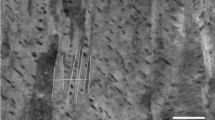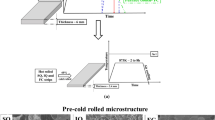Abstract
In a typical process, low carbon steel was annealed at two different temperatures (660°C and 750°C), and then was temper rolled to improve the mechanical properties. Pre-straining and baking treatments were subsequently carried out to measure the bake-hardening (BH) values. The influences of annealing temperature and temper rolling on the BH behavior of the steel were investigated. The results indicated that the microstructure evolution during temper rolling was related to carbon atoms and dislocations. After an apparent increase, the BH value of the steel significantly decreased when the temper rolling reduction was increased from 0% to 5%. This was attributed to the increase in solute carbon concentration and dislocation density. The maximum BH values of the steel annealed at 660°C and 750°C were 80 MPa and 89 MPa at the reductions of 3% and 4%, respectively. Moreover, increasing the annealing temperature from 660 to 750°C resulted in an obvious increase in the BH value due to carbide dissolution.
Similar content being viewed by others
References
Y.H. Cai, C. Wang, and J.S. Zhang, Microstructural characteristics and aging response of Zn-containing Al-Mg-Si-Cu alloy, Int. J. Miner. Metall. Mater., 20(2013), No. 7, p. 659.
J.C. Zhang, R.Y. Fu, M. Zhang, R.D. Liu, X.C. Wei, and L. Li, Bake hardening behavior of TRIP and DP steels, J. Univ. Sci. Technol. Beijing, 15(2008), No. 2, p. 132.
S. Gündüz and A. Tosun, Influence of straining and ageing on the room temperature mechanical properties of dual phase steel, Mater. Des., 29(2008), No. 10, p. 1914.
W.C. Jeong, Effect of prestrain on aging and bake hardening of cold-rolled, continuously annealed steel sheets, Metall. Mater. Trans. A, 29(1998), No. 2, p. 463.
J.Z. Zhao, A.K. De, and B.C. Cooman, Formation of the Cottrell atmosphere during strain aging of bake-hardenable steels, Metall. Mater. Trans. A, 32(2001), p. 417.
J. Barros, A. Targhetta, O. León, T. Ros, J. Schnelder, and Y. Houbaert, Effect of temper rolling on the texture formation and magnetic properties of non-oriented semi-processed electrical steel, J. Magn. Magn. Mater., 316(2007), No. 2, p. 865.
Q.L. Ma, D.C. Wang, H.M. Liu, and H.M. Lu, Effect of temper rolling on tensile properties of low-Si Al-killed sheet steel, J. Iron Steel Res. Int., 16(2009), No. 3, p. 64.
K. Dehghani and A. Nekahi, Artificial neural network to predict the effect of thermomechanical treatments on bake hardenability of low carbon steels, Mater. Des., 31(2010), No. 4, p. 2224.
J. Merlin, P. Merle, S. Garnier, M. Bouzekri, and M. Soler, Experimental determination of the carbon solubility limit in ferritic steels, Metall. Mater. Trans. A, 35(2004), No. 6, p. 1655.
A.H. Cottrell and B.A. Bilby, Dislocation theory of yielding and strain ageing of iron, Proc. Phys. Soc. Sect. A, 62(1949), p. 49.
H. Alihosseini and K. Dehghani, Bake hardening of ultra-fine grained low carbon steel produced by constrained groove pressing, Mater. Sci. Eng. A, 549(2012), p. 157.
Y.C. Tan, Physical Properties Measurement and Research Methods in Metallic Materials, The Metallurgical Industry Press, Beijing, 1989, p. 115.
A.K. De, K. De Blauwe, S. Vandeputte, and B.C. De Cooman, Effect of dislocation density on the low temperature aging behavior of an ultra low carbon bake hardening steel, J. Alloys Compd., 310(2000), No. 1–2, p. 405.
L.Y. Shi, Y.M. Liu, J.H. Huang, S.Q. Zhang, and X.K. Zhao, Growth kinetics of cubic carbide free layers in graded cemented carbides, Int. J. Miner. Metall. Mater., 19(2012), No. 1, p. 64.
X. Wei, Y.P. Hu, and L.B. Pan, Continuous annealing and temper rolling process of ultra-low-carbon cold rolled bake-hardening steel, Trans. Mater. Heat Treat., 33(2012), No. 2, p. 116.
A.K. De, S. Vandeputte, and B.C. De Cooman, Kinetics of strain aging in bake hardening ultra low carbon steel: a comparison with low carbon steel, J. Mater. Eng. Perform., 10(2001), No. 5, p. 567.
H. Wang, W. Shi, Y.L. He, P.P. Liu, and L. Li, Variation of solute distributions during deformation and bake hardening process and their effect on bake hardening phenomenon in ultra-low carbon bake hardening steels, J. Mater. Sci., 46(2011), No. 18, p. 5916.
Author information
Authors and Affiliations
Corresponding author
Rights and permissions
About this article
Cite this article
Kuang, Cf., Zhang, Sg., Li, J. et al. Effect of temper rolling on the bake-hardening behavior of low carbon steel. Int J Miner Metall Mater 22, 32–36 (2015). https://doi.org/10.1007/s12613-015-1040-z
Received:
Revised:
Accepted:
Published:
Issue Date:
DOI: https://doi.org/10.1007/s12613-015-1040-z




